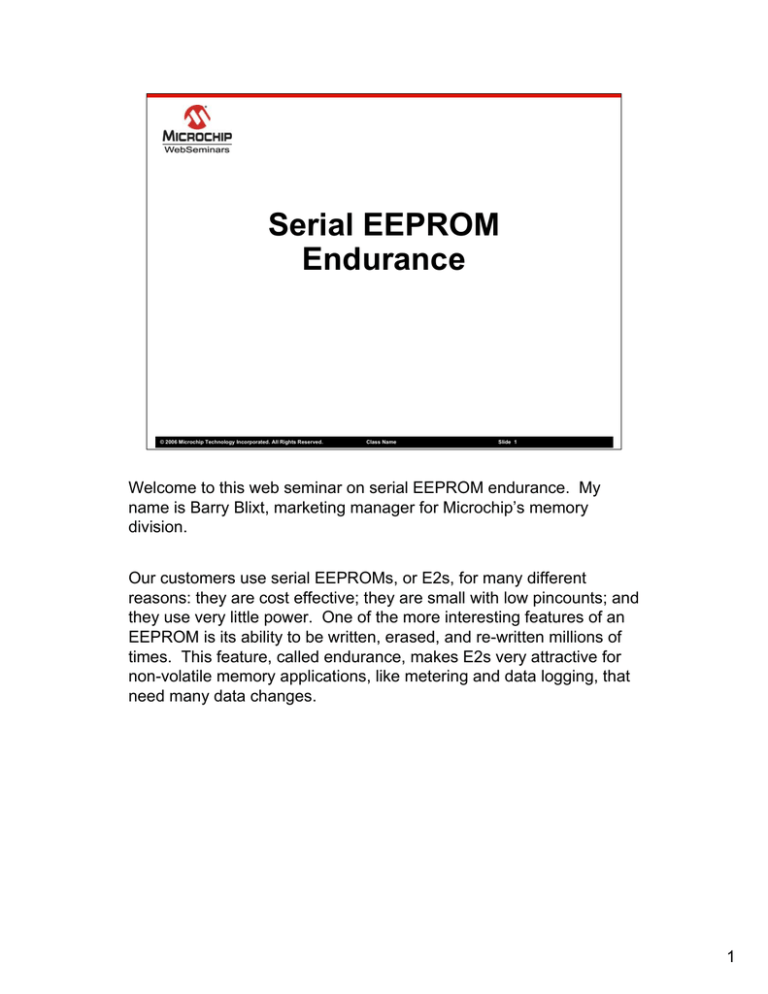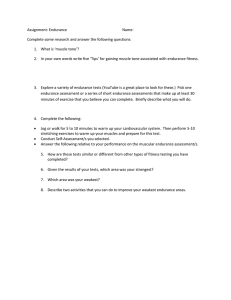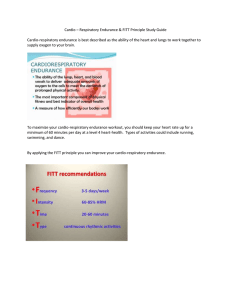
Serial EEPROM
Endurance
© 2006 Microchip Technology Incorporated. All Rights Reserved.
Class Name
Slide 1
Welcome to this web seminar on serial EEPROM endurance. My
name is Barry Blixt, marketing manager for Microchip’s memory
division.
Our customers use serial EEPROMs, or E2s, for many different
reasons: they are cost effective; they are small with low pincounts; and
they use very little power. One of the more interesting features of an
EEPROM is its ability to be written, erased, and re-written millions of
times. This feature, called endurance, makes E2s very attractive for
non-volatile memory applications, like metering and data logging, that
need many data changes.
1
Topics
1.
2.
3.
4.
Defining terms
Ways to improve endurance
Microchip’s Total EnduranceTM model
Actual endurance data
We want you to understand Endurance
so you can make good design choices…
© 2006 Microchip Technology Incorporated. All Rights Reserved.
EEPROM Endurance
Slide 2
This web seminar has 4 topics:
First, we will define some important terms regarding endurance. We’ll also talk about the limitations
of data sheet definitions.
The second part of this web seminar will describe how designers can maximize EEPROM endurance
in actual applications. This will include a description of how EEPROMs work and their typical failure
mechanisms. A key point of this section is that endurance is very dependent on operating conditions.
The third topic is an example problem using Microchip’s Total EnduranceTM tool, a software model
that calculates expected failure rates of Microchip EEPROMs given specific operating conditions.
This tool is available for free on our web site.
For the 4th and final topic, I will share with you the results of some actual endurance testing we
performed on several manufacturers’ EEPROMs.
The overall purpose of this seminar is to give you a good understanding of endurance so that you can
make good design choices.
2
Endurance:
O
Erase/write cycles before failure
© 2006 Microchip Technology Incorporated. All Rights Reserved.
EEPROM Endurance
Slide 3
Let’s define some terms: Endurance is defined as the number of times that a memory device can
be written and re-written before it fails to read back the proper data.
3
Endurance:
O
Erase/write cycles before failure
© 2006 Microchip Technology Incorporated. All Rights Reserved.
EEPROM Endurance
Slide 4
Each programming cycle is usually referred to as an erase/write cycle, since virtually all
EEPROMs include an automatic erase step before programming. Since E2s can be programmed
down to the byte level, an erase/write cycle could be for as little as one byte to as much as a full
page. We will see later how these different write modes have an effect on endurance.
4
Endurance:
O
Erase/write cycles before failure
© 2006 Microchip Technology Incorporated. All Rights Reserved.
EEPROM Endurance
Slide 5
Failures occur because an EEPROM cell can wear out – but, this takes a long time, typically
millions of cycles. Once even a single bit can no longer be reliably programmed, the entire
device is defined to have failed.
5
Endurance:
O
Erase/write cycles before failure
Data Sheet
O
O
1 M cycles, 25ºC
Limited usefulness
© 2006 Microchip Technology Incorporated. All Rights Reserved.
EEPROM Endurance
Slide 6
Another issue that needs some definition is how endurance is specified on data sheets.
Microchip, as well as most other manufacturers, specifies endurance on its data sheets as 1
million erase/write cycles at 25 degrees C.
But what about endurance at other temperatures? What about 2 million or 3 million cycles? Can
a designer expect zero fails before 1 million cycles, or just a small number? Do parts built by
different manufacturers have similar endurance characteristics? Just using the data sheet does
not give an engineer sufficient information to answer these questions.
6
Endurance:
O
Erase/write cycles before failure
Data Sheet
O
O
1 M cycles, 25ºC
Limited usefulness
© 2006 Microchip Technology Incorporated. All Rights Reserved.
Total EnduranceTM s/w
O
O
Actual conditions
What-if analyses
EEPROM Endurance
Slide 7
That’s why we created the Total EnduranceTM modeling software. The model calculates results
based on the actual operating conditions that can have a major effect on endurance. The
software also allows designers to create what-if scenarios to help in decision making.
With that, let’s look at how EEPROMs work and what causes them to fail.
7
EEPROM Cell Structure
Control Gate
(Row)
Floating Gate
Drain
(Column)
Source
Source
Substrate
© 2006 Microchip Technology Incorporated. All Rights Reserved.
EEPROM Endurance
Slide 8
A typical EEPROM cell contains 2 transistors, or gates. of how an EEPROM cell works, we can look
at ways that a designer can get more cycles out of a device in a particular application.
8
EEPROM Cell Structure
Control Gate
(Row)
Thin Oxide
Layer
Floating Gate
Drain
(Column)
Source
Source
Substrate
© 2006 Microchip Technology Incorporated. All Rights Reserved.
EEPROM Endurance
Slide 9
The floating gate is electrically isolated from the rest of the cell by a thin oxide layer.
9
EEPROM Cell Structure
15-20 V
Control Gate
(Row)
Thin Oxide
Layer
Floating Gate
Drain
(Column)
Source
Source
Substrate
© 2006 Microchip Technology Incorporated. All Rights Reserved.
EEPROM Endurance
Slide 10
To program the cell, a voltage differential is applied. A charge pump increases the 1.8 to 5.5 volt
supply voltage up to 15 to 20 volts.
10
EEPROM Cell Structure
15-20 V
Control Gate
(Row)
Thin Oxide
Layer
Floating Gate
Drain
(Column)
Source
Source
Substrate
0V
© 2006 Microchip Technology Incorporated. All Rights Reserved.
EEPROM Endurance
Slide 11
If this high voltage is applied to the control gate, and the drain is connected to ground,
11
EEPROM Cell Structure
15-20 V
Control Gate
(Row)
Floating Gate
Thin Oxide
Layer
Drain
(Column)
Source
Source
Substrate
0V
ee-
e-
© 2006 Microchip Technology Incorporated. All Rights Reserved.
e-
e-
e-
EEPROM Endurance
e-
eSlide 12
electrons will move from the substrate, though the thin oxide layer, and onto the floating gate, giving it
a negative charge.
12
EEPROM Cell Structure
15-20 V
Control Gate
(Row)
Thin Oxide
Layer
ee-
Floating
Gate
-
e-
e-
e
e-
Drain
(Column)
e
e-
FowlerNordheim
Tunneling
Source
Source
Substrate
0V
© 2006 Microchip Technology Incorporated. All Rights Reserved.
EEPROM Endurance
Slide 13
This is a quantum-mechanical process known as Fowler-Nordheim tunneling. The key to this
tunneling is that the electrons barely disturb the oxide layer, so the process can be repeated millions
of times. A flash cell uses a different programming technique, called Channel Hot Electron
Programming, that damages the oxide layer with every write. That’s why E2’s have much higher
endurance than flash, which is usually specified to only 10,000 cycles.
Reversing the voltage differential causes negatively-charged electrons to leave the floating gate and
move back into the substrate, leaving the gate with a lack of electrons and a positive charge. This
charge on the floating gate determines if the cell, or bit, is a 1 or a zero. If the voltage differential is
removed, the electrons stay where they are. Since the floating gate keeps its positive or negative
charge when the power is turned off, the EEPROM is non-volatile.
An EEPROM cell fails when the built-in sensing circuitry can no longer determine the charge on the
floating gate. After many erase/write cycles, field stresses and the constant tunneling through the thin
oxide layer begin to reduce the voltage differential. Also, the thin oxide can begin to leak charge from
the floating gate, so the cell is no longer non-volatile. In any of these failure modes, a sense amp can
no longer tell the difference between a 1 or a zero.
So, obviously an important part of endurance is the intrinsic structure of the cell. Microchip’s
EEPROM cell was designed to maximize the amount of endurance available.
But it’s not all about the cell structure. Now that we understand the mechanics of how an EEPROM
cell works, we can look at ways that a designer can get more cycles out of a device in a particular
application.
13
Key Effects on Endurance
1. TEMPERATURE & VOLTAGE
• Lower is Better
3. DATA OPTIONS
• Minimize writes
2. WRITE MODE
• Page Mode is Better
© 2006 Microchip Technology Incorporated. All Rights Reserved.
EEPROM Endurance
Slide 14
There are 3 major effects on endurance that designers need to be aware of.
The first is the operating conditions of the application. Our research has shown that
higher temperatures and voltages cause faster wear out of the cell. To maximize
endurance, designers should choose the lowest operating temperature and voltage
possible.
The second key effect on endurance is the choice of write mode. When a single
byte is programmed, the energy from the charge pump is concentrated on that one
byte. If a page write is used, that energy is dissipated over more bytes, so cell wear
is decreased. Microchip builds in circuitry to minimize the wear effect of byte writes,
but overall, designers should use Page mode whenever possible.
The third endurance effect is the designer’s choice of how often he programs the
data. Writing as infrequently as possible will lengthen the device’s life.
We’ll see the effects of changing these parameters in the example of our modeling
software. Let’s look at the model now.
14
© 2006 Microchip Technology Incorporated. All Rights Reserved.
EEPROM Endurance
Slide 15
Here is a screen shot of the Total EnduranceTM interface.
15
Devices
© 2006 Microchip Technology Incorporated. All Rights Reserved.
EEPROM Endurance
Slide 16
First, you can pick the Microchip device that you want to model. All Microchip
memory devices are included, and we add new devices when they are released.
16
Inputs
© 2006 Microchip Technology Incorporated. All Rights Reserved.
EEPROM Endurance
Slide 17
Next, you can enter your application’s actual operating conditions. Since endurance
is impacted by voltage, temperature, and how the part is programmed, this input
section is really the key to the whole model. It is very easy to change a parameter.
17
Options
© 2006 Microchip Technology Incorporated. All Rights Reserved.
EEPROM Endurance
Slide 18
The options section, shown here, lets you select how you want to see the results.
18
Results
© 2006 Microchip Technology Incorporated. All Rights Reserved.
EEPROM Endurance
Slide 19
Finally, the results section shows endurance data in both numerical and graphical
format. This data can be exported to spreadsheet or presentation software.
Now, let’s look at an example problem.
19
Truck Odometer Example:
85º C
5.5 V
600 miles
per day
12 bytes
per cycle
Goal: <5 ppm, 15 years
© 2006 Microchip Technology Incorporated. All Rights Reserved.
EEPROM Endurance
Slide 20
Assume we are designing a truck odometer. The odometer has an electronic
logbook that is updated every mile so that transportation billing can be accurately
measured.
The odometer is mounted in the engine compartment where temperatures can
reach 85 degrees C. The truck’s electronics operate at 5.5 volts. Twelve bytes of
data are written to the EEPROM every mile, and the truck can travel up to 600 miles
in a day. Our goal in this example is to have the E2 last for 15 years with fewer
than 5 parts per million, or ppm, fails.
A little math tells us that the device will be expected to handle over 3 million
erase/write cycles in its 15-year life.
The datasheet only tells us that we can expect to see 1 million cycles at 25C. Let’s
see how the Total EnduranceTM model can give us more specific information.
20
Truck Odometer Options:
Goal: <5 ppm, 15 years
Option 1: 11 ppm, 15 years
Option 2: 5 ppm, 8 years
Option 3: 5 ppm, 15 years (300 cycles)
© 2006 Microchip Technology Incorporated. All Rights Reserved.
EEPROM Endurance
Slide 21
Here is a summary of the options that we just found from the Total
EnduranceTM model. These all assume that the odometer has been
moved from the hot engine compartment into the cooler truck cab. The
goal was to see less than 5 ppm fails after 15 years.
The first option gave us 11 ppm after 15 years of service. Option 2 was
5 ppm after 8 years. The final option was to lower the total number of
writes, and the unit will last for 15 years with only 5 ppm fails.
With the help of the model, we quickly found a way to improve the
design to an acceptable risk level. Now we can make an informed
decision about how long to warranty the product.
21
www.microchip.com
© 2006 Microchip Technology Incorporated. All Rights Reserved.
EEPROM Endurance
Slide 22
We have more information on EEPROMs and endurance on our web site.
22
www.microchip.com
O
Download Total EnduranceTM model
Æ Search “Total Endurance”
© 2006 Microchip Technology Incorporated. All Rights Reserved.
EEPROM Endurance
Slide 23
I encourage you to download the Total EnduranceTM software. It’s free, and easy to
access. Just go to www.microchip.com and search for “total endurance.”
Once you’ve downloaded the model, check out both the FAQs and the Tutorial that
are available in the Help menus. There is a more detailed discussion about
common endurance misconceptions, cell design, failure mechanisms, and how our
engineers developed the model.
23
www.microchip.com
O
Download Total EnduranceTM model
Æ Search “Total Endurance”
O
More information on Endurance
1. AN 1019: Endurance Tutorial
2. AN 562: Using Total Endurance S/W
© 2006 Microchip Technology Incorporated. All Rights Reserved.
EEPROM Endurance
Slide 24
We have two excellent app notes about endurance on our web site. The first – AN
1019 – describes endurance in more detail. The second – AN 562 – has more hints
about how to use the Total Endurance tool.
24
www.microchip.com
O
Download Total EnduranceTM model
Æ Search “Total Endurance”
O
More information on Endurance
1. AN 1019: Endurance Tutorial
2. AN 562: Using Total Endurance S/W
O
Other memory web seminars
© 2006 Microchip Technology Incorporated. All Rights Reserved.
EEPROM Endurance
Slide 25
We also have two other web seminars on serial E2s: an introduction to serial
EEPROMs and an introduction to our SEEVAL® 32 developers kit.
25
www.microchip.com
O
Download Total EnduranceTM model
Æ Search “Total Endurance”
O
More information on Endurance
1. AN 1019: Endurance Tutorial
2. AN 562: Using Total Endurance S/W
O
Other memory web seminars
O
One more thing…
© 2006 Microchip Technology Incorporated. All Rights Reserved.
EEPROM Endurance
Slide 26
One last issue: I mentioned that the Total Endurance model is only good for
Microchip devices. Next, I want to address one more question: are all suppliers’
EEPROMs the same?
26
Endurance Test Results:
3 Manufacturers
% Fails
100%
80%
60%
40%
20%
0
500,000
1,000,000
2,000,000
1,500,000
Erase/write cycles at 85º C
© 2006 Microchip Technology Incorporated. All Rights Reserved.
EEPROM Endurance
Slide 27
You now know enough about endurance to predict that EEPROMs from different suppliers, and, therefore, from different manufacturing processes, will
have very different endurance characteristics. To confirm that theory, Microchip recently performed some actual, destructive endurance testing on
several different manufacturers’ devices, including our own. I’ll show you the results from 3 manufacturers on this slide. In all cases, the device’s
data sheet specified 1 million erase/write cycles.
First a word on the test methodology. We purchased all competitors’ parts through commercial web sites; we ordered standard Microchip parts from
our own sample center. We tested 128 EEPROMs from each manufacturer, each a 16-kbit, I2CTM device. The parts were cycled 2 million times
using a random data pattern. We cycled at a high temperature – 85 deg C – in order to accelerate wear and speed up the test. Each part was
read every 100,000 cycles to see if it had failed, that is, if one or more bits were incorrect. We used PDIP packages, wrote in page mode, and
operated at 5.5 volts.
Notice that the empty graph now on the slide looks a lot like the Total EnduranceTM graphical output. The major differences are 1) the y-axis here is in
percent fails not ppm and 2) while the Total Endurance tool is a model, this data is based on actual cycling.
27
Endurance Test Results:
3 Manufacturers
% Fails
100%
1st read
point
80%
60%
40%
20%
0
500,000
1,000,000
2,000,000
1,500,000
Erase/write cycles at 85º C
© 2006 Microchip Technology Incorporated. All Rights Reserved.
EEPROM Endurance
Slide 28
Here are the results from the first read point for supplier number 1. After only 100,000 cycles, there were already some failing parts.
28
Endurance Test Results:
3 Manufacturers
% Fails
100%
80%
60%
2nd read
point
40%
20%
0
500,000
1,000,000
2,000,000
1,500,000
Erase/write cycles at 85º C
© 2006 Microchip Technology Incorporated. All Rights Reserved.
EEPROM Endurance
Slide 29
Now I will add data from the 2nd read point, at 200,000 cycles. There are more fails, on the order of 2%, But, 2% means 20,000 ppm!
29
Endurance Test Results:
3 Manufacturers
% Fails
100%
80%
100%
fails
60%
40%
20%
0
500,000
1,000,000
2,000,000
1,500,000
Erase/write cycles at 85º C
© 2006 Microchip Technology Incorporated. All Rights Reserved.
EEPROM Endurance
Slide 30
Here is the rest of the test data for the first supplier. By the end of the test, 100% of the 128 units that we tested failed. This is a very harsh test
environment, well above the data sheet specification, but the results are not very impressive.
30
Endurance Test Results:
3 Manufacturers
% Fails
100%
80%
100%
fails
60%
40%
20%
0
500,000
1,000,000
2,000,000
1,500,000
Erase/write cycles at 85º C
© 2006 Microchip Technology Incorporated. All Rights Reserved.
EEPROM Endurance
Slide 31
This 2nd vendor had better results. Still, after the 2-million cycle test, 20% of the units had failed.
31
Endurance Test Results:
3 Manufacturers
% Fails
100%
80%
100%
fails
60%
40%
20%
0
Early
fails
500,000
1,000,000
2,000,000
1,500,000
Erase/write cycles at 85º C
© 2006 Microchip Technology Incorporated. All Rights Reserved.
EEPROM Endurance
Slide 32
And, note that both these suppliers exhibited several early fails before the first read point of 100,000 cycles. Eliminating these early fails is crucial,
since most applications never reach millions of cycles.
32
Endurance Test Results:
3 Manufacturers
% Fails
100%
80%
100%
fails
60%
40%
20%
0
Early
fails
500,000
1,000,000
Erase/write cycles at 85º C
© 2006 Microchip Technology Incorporated. All Rights Reserved.
EEPROM Endurance
2,000,000
1,500,000
Microchip: 0 fails
Slide 33
Finally, I will add the Microchip results. Microchip devices showed no fails throughout the entire test. Now that the 3 curves are on the graph, you can
really see the drastic differences in endurance results. We make the following 3 conclusions from this data:
1. EEPROMS made by different manufacturers can have drastically different endurance characteristics
2. All these parts were specified to 1 million cycles. Data sheet definitions are not enough to make good decisions in harsh conditions.
3. This test emphasizes Microchip’s reputation of having excellent endurance
To expand on that last point, we at Microchip are very proud of our endurance. We spend a lot of resources designing parts that will have excellent
endurance, and we also use extensive testing to reduce early fails and ensure outgoing quality. Even if your application does not need millions of
cycles, you can be assured that Microchip parts are built and tested to the highest quality.
33
EEPROM Endurance
O
O
O
O
Definitions and Education
Ways to improve endurance
Total EnduranceTM software
Endurance testing
Thanks!
© 2006 Microchip Technology Incorporated. All Rights Reserved.
EEPROM Endurance
Slide 34
And that concludes this web seminar. Let’s review the major topics we covered.
We had a quick review of endurance and defined some key terms, including a warning about how
data sheet definitions can be incomplete.
Then we talked about the cell structure of EEPROMs and some ways that engineers can increase
endurance in specific applications.
We completed an example case using our Total EnduranceTM software, highlighting how quick and
easy it is to make design decisions.
Finally, we just looked at some endurance data from different suppliers that emphasized the
differences among products.
Our goal is to help you understand EEPROM endurance so you can make good design decisions.
The centerpiece of that education is the Total Endurance software – the only model of its type in the
industry.
Thanks very much for your time.
34




